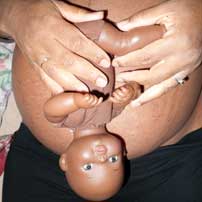-
- The easiest clue for pregnant women to feel is whether the baby has limb movements on both sides of her abdomen, right and left. If the hands and knees are on either side of her navel (below and beside it, usually), it’s a good bet the baby is posterior.
How can you tell if the baby is ROP or ROT and does it really matter?
The first baby coming from the mother’s right more often has his or her back extended to match the right obliquity of the uterus. Extension is the biggest challenge of any posterior baby who has that posture.
The midwife will feel that the head is narrow and may think it is the nape of the neck. The difference is that the baby won’t play with the hands behind his or her back. So if the head feels narrow and their are hands present you can be confident that the baby is facing forward. The head may remain high in a first time mother. If the baby had been breech recently before flipping head down, this is a common position to “land” in. Heart tones are heard far to the right and with a little difficulty; hearing them, then losing them, then hearing them again.
The ROT baby’s head will feel broader. The hands, if felt at all, will only be on the left of center. Heart tones are heard on the right side.
The ROA baby’s hands can not be felt at all. The back is broad and obvious and the heart tones can be heard with a simple fetoscope over a wide area.
The Right Occiput Posterior Baby in Labor
Example A: Baby has not engaged when labor starts
The first baby will use strong contractions to rotate to the Right Occiput Transverse, occasionally taking a day or night of strong contractions. Then there is often a resting period. Then the first time mother’s labor will start up again and attempt to move the baby to the left occiput transverse position. Strong contractions will be necessary and suddenly the baby will be left occiput transverse. A second lull or resting time is likely. The mother can sleep with a little encouragement. Labor may have taken a day or two at this point and the mother is not further dilated than 3-4 cm typically, and could be less. It doesn’t matter, once the baby is rotated and tucked, the head will come on the cervix and labor will progress as expected.
Next time labor starts up, the labor pattern will be just like in the books, because now she has a LOT baby. The baby’s head can now tuck and let engagement happen. Labor begins again gradually, increasing in strength and the mother finds this bout of contractions much more manageable and predictable, not suddenly long and strong like before.
Do the routine: The Jiggle, Forward-leaning Inversion, Standing Release, and Side-lying Release, and move freely in active birth practices.
Example B: Baby is engaged or “dropped” when labor starts
Labor strength will pick up fairly quickly but dilation may be slow. This will depend on head flexion and the mother’s pelvic floor and pelvic outlet. Balance the pelvic floor in early labor so that, later, when the baby comes down on it, it will be symmetrical. Then, we can avoid an asynclitism (tipped head) or we can make room for an asynclitism if we have one. With a pelvis that is longer front to back (anthropoid), or with a round pelvis (gynecoid), and a small or average baby, we expect labor to proceed well. If the outlet is small or the mother’s tailbone is positioned far inward, hiding deep in her glute muscles, there will be a need for some intense work to move the baby down to finish dilation and for pushing. In this case, body work, including myofascial release and cransiosacral releases, can open the outlet, as can maternal positioning.
Again, do the routine: The Jiggle, Forward-leaning Inversion, Standing Release, and Side-lying Release, and move freely in active birth practices.
More on laboring with any ROP baby
The ROP baby is the classic posterior baby in the literature comparing “long arc rotation” with “short arc rotation.”
In long arc rotation, the ROP baby rotates over to an anterior presentation and emerges as an OA baby (when people can finally see the baby they may never have known the baby was OP unless they paid attention before or during labor before the long arc rotation occurred). A few of these babies get stuck in a transverse arrest before rotating all the way to anterior. Where the rotation happens varies, and in turn, so does the length and events of the labor accordingly.
In short arc rotation, the ROP baby rotates a little ways (45 degrees) to direct OP for birth. Half of these babies can be born without surgery.
Whether the ROP baby has a hard time rotating and descending through the pelvis has to do with the usual things: balance in the mother’s soft tissues, symmetry in the pelvic floor, pelvic size and shape, and how well the baby’s head is tucked. It also depends on whether the mother labors actively upright when she isn’t resting and is free to move and eat in labor.


